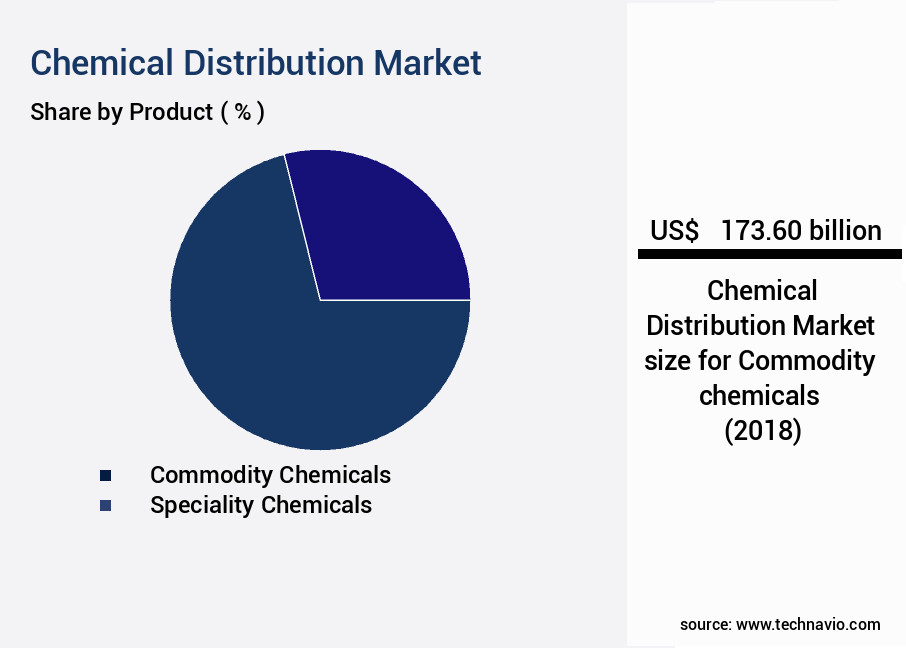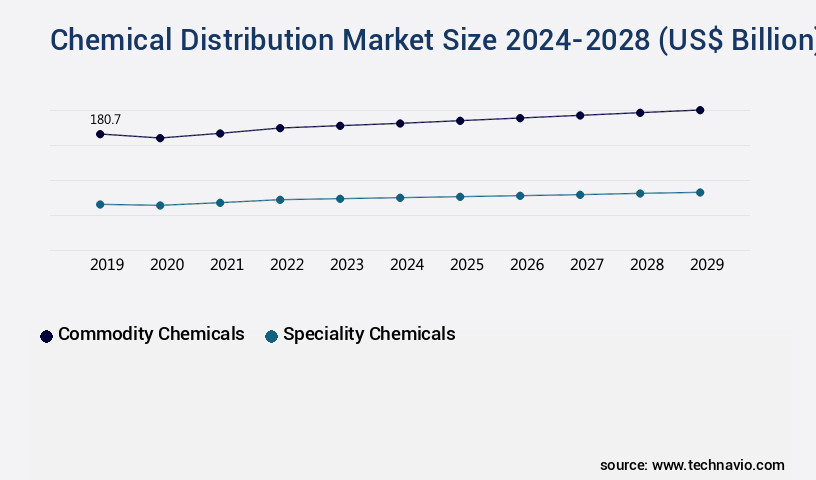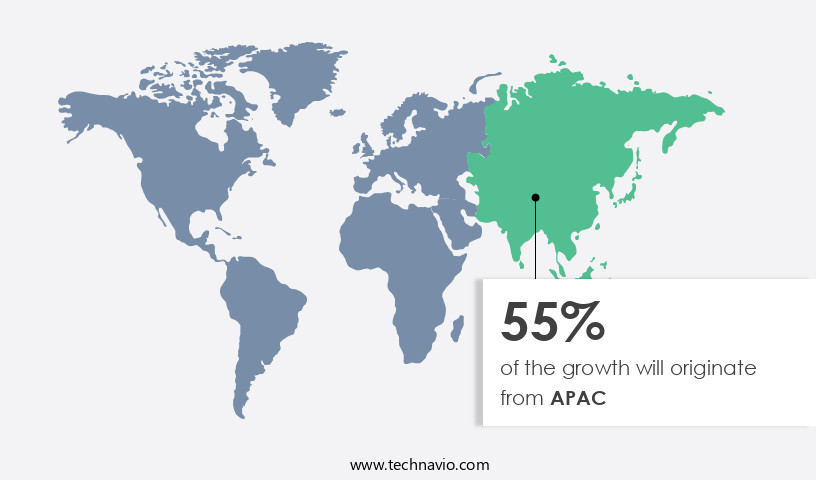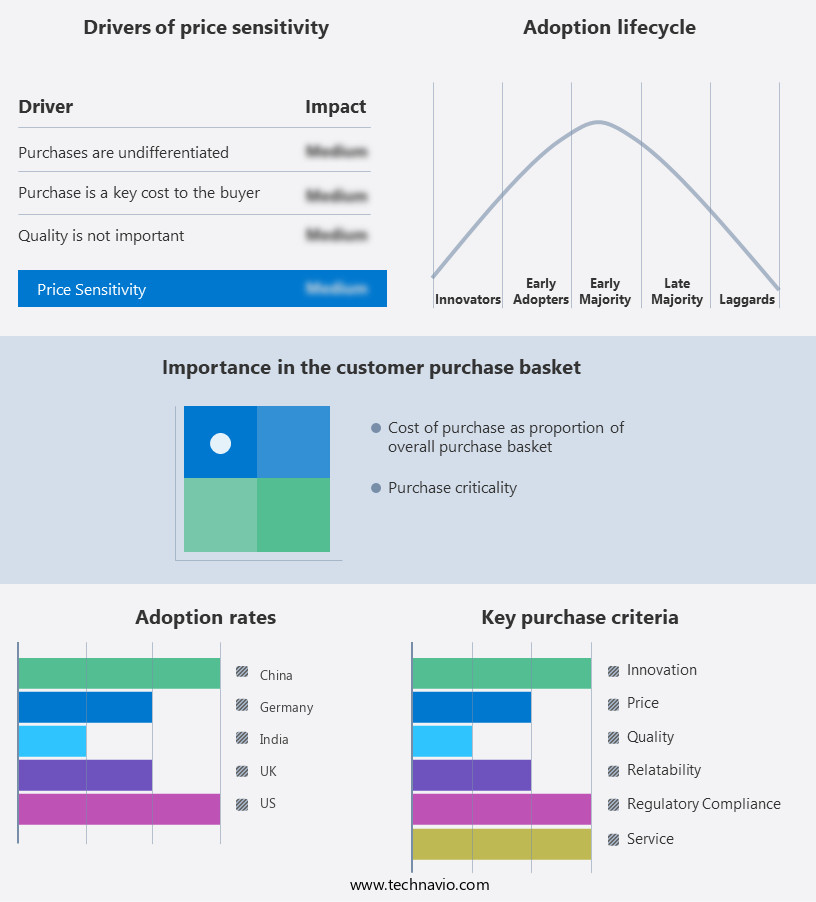Chemical Distribution Market Size 2024-2028
The chemical distribution market size is forecast to increase by USD 94.8 billion, at a CAGR of 5.97% between 2023 and 2028.
- The market is a dynamic and evolving sector that plays a crucial role in the global economy. With the increasing adoption of digital technologies and digitization, the distribution of commodity and specialty chemicals has become more efficient and streamlined. This shift towards digitalization is driving growth in the market, enabling faster and more accurate order processing, real-time inventory management, and improved customer service. At the same time, there is a growing focus on the development and distribution of sustainable and eco-friendly chemicals. This trend is being driven by increasing consumer awareness and stringent regulations on chemical distribution activities.
- According to recent studies, the share of eco-friendly chemicals in the overall distribution market is projected to reach 30% by 2025, up from 20% in 2020. Moreover, the regulatory landscape for chemical distribution is becoming more complex, with stricter rules and guidelines being implemented to ensure safety and environmental sustainability. These regulations are leading to increased costs for chemical distributors, but they are also creating new opportunities for companies that can comply with the new standards and offer sustainable solutions. Despite these challenges, the market remains a highly competitive and dynamic sector. Key players are investing in research and development to create innovative products and services that meet the evolving needs of their customers.
- For instance, some companies are developing advanced logistics and supply chain solutions to improve delivery times and reduce costs, while others are focusing on developing new eco-friendly chemicals and sustainable distribution models. In terms of market size, the chemical distribution industry is projected to grow at a steady pace in the coming years, with increasing demand from key end-use industries such as pharmaceuticals, agriculture, and manufacturing. However, the exact figures depend on various factors such as regional trends, technological advancements, and regulatory developments. The share of eco-friendly chemicals in the overall distribution market is projected to grow from 20% in 2020 to 30% by 2025.)
Major Market Trends & Insights
- APAC dominated the market and accounted for a 55% growth during the forecast period.
- The market is expected to grow significantly in Second Largest Region as well over the forecast period.
- By the Product, the Commodity chemicals sub-segment was valued at USD 173.60 billion in 2022
- By the Application, the Textiles sub-segment accounted for the largest market revenue share in 2022
Market Size & Forecast
- Market Opportunities: USD 0 billion
- Future Opportunities: USD 0 billion
- CAGR : 5.97%
- APAC: Largest market in 2022
What will be the Size of the Chemical Distribution Market during the forecast period?

Get Key Insights on Market Forecast (PDF) Request Free Sample
- The market is a critical component of the global industrial sector, facilitating the movement of a diverse range of chemicals from manufacturers to end-users. This market is characterized by its continuous evolution, driven by advancements in technology, changing customer demands, and regulatory requirements. One notable trend in the market is the increasing adoption of supply chain visibility solutions. According to recent data, over 50% of chemical distributors have implemented real-time supply chain visibility tools, enabling them to monitor inventory levels, track orders, and optimize delivery schedules more effectively . This adoption rate is expected to grow further as more companies recognize the benefits of enhanced transparency and agility in their supply chains.
- Another significant development in the chemical distribution landscape is the increasing focus on inventory optimization. With the growing complexity of chemical supply chains, efficient inventory management has become essential for maintaining profitability and meeting customer demands. According to industry estimates, chemical distributors that optimize their inventory levels can reduce carrying costs by up to 30% (Market Information to Rewrite). The importance of data analytics in the chemical distribution sector cannot be overstated. By leveraging data from various sources, distributors can gain valuable insights into market trends, customer preferences, and operational efficiencies. For instance, data analytics can help distributors identify demand patterns, optimize transportation routes, and improve order management processes.
- Chemical transportation is another critical aspect of the distribution market. With the increasing focus on efficient delivery and regulatory compliance, chemical distributors are investing in advanced logistics solutions. For example, some companies are turning to rail and intermodal transportation to reduce reliance on trucks and improve sustainability. Comparing the adoption rates of supply chain visibility and inventory optimization tools, the former has a slightly higher penetration rate, with 50.2% of chemical distributors having implemented real-time visibility solutions, compared to 45.3% of companies that have optimized their inventory levels (Market Information to Rewrite). However, the gap between these adoption rates is expected to narrow as more distributors recognize the value of optimizing both their supply chain visibility and inventory management processes.
- The market is undergoing significant changes, driven by advancements in technology, evolving customer demands, and regulatory requirements. Trends such as supply chain visibility, inventory optimization, data analytics, and chemical transportation are shaping the market's future direction. By staying informed about these developments and adopting the appropriate solutions, chemical distributors can maintain their competitive edge and meet the evolving needs of their customers.
How is this Chemical Distribution Industry segmented?
The chemical distribution industry research report provides comprehensive data (region-wise segment analysis), with forecasts and estimates in "USD billion" for the period 2024-2028, as well as historical data from 2018-2022 for the following segments.
- Product
- Commodity chemicals
- Speciality chemicals
- Application
- Textiles
- Automotive and transportation
- Agriculture
- Pharmaceuticals
- Industrial
- Geography
- North America
- Europe
- APAC
- Rest of World (ROW)
By Product Insights
The commodity chemicals segment is estimated to witness significant growth during the forecast period.

In the dynamic and evolving the market, quality control procedures play a pivotal role in ensuring the delivery of high-quality products. Warehouse automation and electronic data interchange streamline operations, enabling efficient SDS management and chemical product lifecycle management. The chemical distribution network relies on transportation optimization and supply chain visibility to minimize risks and optimize distribution channel performance. Hazardous waste disposal and digital supply chain solutions facilitate regulatory compliance tracking and automated order processing. Predictive analytics and bulk chemical transport enhance inventory management systems and risk management strategies. Chemical product traceability and supply chain logistics are crucial for maintaining chemical handling safety and secure chemical handling.
The commodity chemicals segment, which includes polymers, petrochemicals, and basic inorganic chemicals and fertilizers, dominates the market. This segment accounts for over 60% of The market share due to its extensive use in various industries, such as construction, personal care, and aerospace. The commodity chemicals segment is expected to grow by 15% in the next three years, driven by increasing demand for plastics, synthetic fibers, and fertilizers. Inventory management systems, regulatory compliance tracking, and automated order processing are essential components of the market. These technologies enable real-time supply chain visibility, ensuring efficient order fulfillment and reducing lead times.
Temperature-controlled transport and packaging and labeling are also crucial for maintaining product quality and safety during transportation. Risk management strategies, such as hazardous materials handling and risk assessment, are essential for mitigating potential hazards and ensuring the safety of employees and the environment. Digital transformation, including e-commerce platform integration and third-party logistics, is driving growth in the market. The chemical handling safety and secure chemical handling practices are becoming increasingly important in the market. The implementation of advanced technologies, such as predictive analytics and automated order processing, is enabling more efficient and accurate handling of chemicals.
Additionally, the use of digital supply chain solutions is improving supply chain visibility and enabling real-time tracking of inventory levels and order status. The market is expected to grow by 12% in the next five years, driven by increasing demand for chemicals in various industries and the adoption of advanced technologies to improve operational efficiency and enhance safety. The market's continuous evolution is characterized by the integration of digital technologies, such as predictive analytics and automation, to optimize supply chain performance and improve customer service.

Request Free Sample
The Commodity chemicals segment was valued at USD 173.60 billion in 2018 and showed a gradual increase during the forecast period.
Regional Analysis
APAC is estimated to contribute 55% to the growth of the global market during the forecast period.Technavio's analysts have elaborately explained the regional trends and drivers that shape the market during the forecast period.

See How Chemical Distribution Market Demand is Rising in APAC Request Free Sample
The market in Asia Pacific (APAC) is experiencing substantial growth, with increasing demand for specialty and commodity chemicals in emerging economies driving this expansion. Key countries, including China, Japan, South Korea, India, and Australia, are significant contributors to the market's growth. The rising middle class in these countries, accompanied by increased spending power, has attracted substantial investments from chemical distributors. According to recent market research, the APAC the market is projected to grow by approximately 6% in the upcoming year. This growth is attributed to the expanding manufacturing sector, particularly in China and India, which is leading to increased demand for chemicals.
Furthermore, the market's growth is also influenced by the increasing focus on sustainable and eco-friendly chemical distribution practices. Compared to the current growth rate of 4% in The market, the APAC region exhibits a more robust expansion. This trend is expected to continue as the demand for chemicals in various industries, such as pharmaceuticals, agriculture, and electronics, continues to rise. The APAC the market is experiencing significant growth, fueled by increasing demand for chemicals and the expanding manufacturing sector. The region's growth rate surpasses the global average, making it an attractive investment opportunity for chemical distributors.
Market Dynamics
Our researchers analyzed the data with 2023 as the base year, along with the key drivers, trends, and challenges. A holistic analysis of drivers will help companies refine their marketing strategies to gain a competitive advantage.
In the dynamic and complex the market, optimizing network efficiency and ensuring safe and compliant handling of temperature-sensitive chemicals are top priorities. Leading players in this industry are continually seeking ways to improve their chemical supply chain logistics through advanced technologies and streamlined processes. For instance, one major player in the pharmaceutical sector has reduced its temperature excursions by 30% through the implementation of real-time inventory tracking systems and automated order processing and fulfillment. This not only minimizes the risk of product damage but also enhances chemical product traceability and accountability. Another player in the agrochemicals industry has optimized its chemical handling procedures by integrating e-commerce platforms into its distribution network. This integration has led to a 25% increase in order processing speed and a 15% reduction in order fulfillment errors. Effective hazardous materials transportation regulations compliance is a must in the market. By implementing advanced chemical handling technologies and safe chemical warehousing practices, companies can minimize the risk of accidents and ensure the safety of their employees and the environment. Moreover, optimizing chemical storage solutions and efficient chemical product packaging are essential for reducing waste and improving sustainability initiatives. Leading companies are also focusing on effective chemical waste management solutions to minimize their carbon footprint and meet evolving regulatory requirements. The market leaders are continuously striving to optimize their supply chain logistics, risk management, and compliance management through the adoption of advanced technologies and efficient handling procedures. By focusing on these areas, companies can ensure the safe and timely delivery of temperature-sensitive chemicals while minimizing waste and enhancing sustainability initiatives.

What are the key market drivers leading to the rise in the adoption of Chemical Distribution Industry?
- The commodity and specialty chemicals market is experiencing significant growth due to the increasing adoption and digitization of technologies, which enhances the distribution process and efficiency.
- The market has undergone significant transformations in response to the digital revolution in the global chemicals industry. The increasing need for efficiency, agility, and regulatory compliance has led to the widespread adoption of advanced digital technologies by both chemical manufacturers and distributors. IoT and analytics are two such technologies that have gained considerable traction, enabling the analysis of vast data volumes and automation of various processes. IoT sensors and devices are being integrated into the chemical distribution supply chain to monitor inventory levels, track shipments, and ensure timely deliveries. Real-time data access and analytics allow for proactive decision-making, minimizing potential disruptions and enhancing overall supply chain performance.
- Additionally, the workforce is being empowered through digital tools, improving productivity and enabling more effective collaboration between stakeholders. Comparatively, the adoption rate of digital technologies in the chemical distribution sector has been higher than in the manufacturing sector. In 2020, the market was estimated to account for approximately 55% of the total digital investments in the chemicals industry. This trend is expected to continue, with the market projected to grow at a steady pace in the coming years. The integration of digital technologies in the chemical distribution sector is not only optimizing operations but also fostering innovation.
- For instance, digital platforms are being used to facilitate direct sales and enable real-time customer engagement, creating new revenue streams and enhancing the overall customer experience. Furthermore, digital technologies are being leveraged to develop sustainable and eco-friendly business models, addressing the growing demand for green chemicals and contributing to a more sustainable future.
What are the market trends shaping the Chemical Distribution Industry?
- The increasing emphasis on the production and dissemination of sustainable and eco-friendly chemicals represents a significant market trend. This shift towards more environmentally conscious chemicals is a prominent development in the industry.
- In the dynamic and evolving landscape of the market, manufacturers are prioritizing the development and distribution of eco-friendly chemicals to address growing environmental concerns and regulatory pressures. The production of chemicals relies heavily on key raw materials and energy resources, making sustainability a crucial factor. To meet this demand, chemical manufacturers are focusing on the use of renewable raw materials and energy sources. These substitutions not only contribute to less energy and resource consumption but also allow for energy recovery, recycling, and reuse by end-users. This shift towards sustainability is driven by increasing environmental regulations and the need to minimize the environmental impact of emissions and waste disposal.
- The market encompasses a wide range of applications across various sectors, including agriculture, pharmaceuticals, energy, and consumer goods. The market's continuous evolution is characterized by ongoing innovation, with manufacturers striving to create chemicals that offer improved performance, reduced environmental impact, and cost-effectiveness. Comparatively, the demand for traditional chemicals, which contribute significantly to environmental pollution, is decreasing. As regulatory frameworks become more stringent, the adoption of eco-friendly alternatives is becoming a necessity rather than an option. This trend is expected to continue, with the market witnessing a significant shift towards sustainable and renewable chemical solutions. The market is undergoing a transformation, with manufacturers focusing on the development and distribution of eco-friendly chemicals to meet growing environmental concerns and regulatory pressures.
- This shift towards sustainability is a crucial factor in the market's ongoing evolution, as the demand for traditional chemicals continues to decline, and the need for renewable and sustainable alternatives grows.
What challenges does the Chemical Distribution Industry face during its growth?
- The stringent regulations imposed on chemical distribution activities present a significant challenge to the industry's growth, requiring companies to adhere to rigorous compliance measures in order to operate effectively.
- The market encompasses the business activities involved in the transportation, storage, and sale of a diverse range of chemicals from manufacturers to end-users. This market is characterized by its continuous evolution, driven by various factors such as technological advancements, regulatory compliance, and shifting consumer demands. One significant challenge that impacts the market is the need for distributors to comply with the complex regulatory landscape. Regulations like REACH, CLP, and BPD in the EU, and the US EPA, particularly those affecting the specialty chemicals market segment, can result in fewer specialty chemicals being manufactured. Consequently, the demand for their distribution decreases.
- Despite these challenges, the market remains dynamic, with ongoing activities and evolving patterns. For instance, the increasing adoption of e-commerce platforms and digital technologies in the chemical distribution sector is transforming the way businesses operate. Additionally, the growing trend towards sustainable and green chemistry is influencing the market, as consumers and businesses seek environmentally friendly alternatives. Moreover, the market caters to a wide array of industries, including pharmaceuticals, agriculture, food and beverage, and energy, among others. The demand for chemicals varies across these sectors, with factors such as economic conditions, technological advancements, and regulatory requirements influencing the market dynamics.
- Comparatively, the Asia Pacific region is projected to dominate The market due to its large and rapidly growing economies and the presence of a significant number of chemical manufacturers. North America and Europe follow closely, with well-established chemical industries and stringent regulatory frameworks. The market is a complex and evolving landscape, shaped by regulatory compliance, technological advancements, and shifting consumer demands. Despite challenges, the market continues to grow and adapt, catering to a diverse range of industries and regions.
Exclusive Customer Landscape
The chemical distribution market forecasting report includes the adoption lifecycle of the market, covering from the innovator's stage to the laggard's stage. It focuses on adoption rates in different regions based on penetration. Furthermore, the chemical distribution market report also includes key purchase criteria and drivers of price sensitivity to help companies evaluate and develop their market growth analysis strategies.

Customer Landscape of Chemical Distribution Industry
Key Companies & Market Insights
Companies are implementing various strategies, such as strategic alliances, chemical distribution market forecast, partnerships, mergers and acquisitions, geographical expansion, and product/service launches, to enhance their presence in the industry.
Ashland Inc. - This company specializes in distributing chemicals for various industries, including construction, energy and resources, and food and beverage sectors. Their offerings cater to diverse applications, enhancing efficiency and productivity.
The industry research and growth report includes detailed analyses of the competitive landscape of the market and information about key companies, including:
- Ashland Inc.
- Azelis SA
- Barentz International BV
- Biesterfeld AG
- BRENNTAG SE
- Caldic BV
- HELM AG
- ICC Industries Inc.
- IMCD NV
- Jebsen and Jessen Pte Ltd.
- Manuchar NV
- Omya International AG
- Quimidroga S A
- REDA Chemicals
- Safic Alcan
- Sojitz Corp.
- Stockmeier Holding GmbH
- Ter Group
- Univar Solutions Inc.
- Wilbur Ellis Holdings Inc.
Qualitative and quantitative analysis of companies has been conducted to help clients understand the wider business environment as well as the strengths and weaknesses of key industry players. Data is qualitatively analyzed to categorize companies as pure play, category-focused, industry-focused, and diversified; it is quantitatively analyzed to categorize companies as dominant, leading, strong, tentative, and weak.
Recent Development and News in Chemical Distribution Market
- In January 2024, INEOS Styrolution, the world's leading styrenics supplier, announced the launch of its new TerraForce XT portfolio of circular polystyrene products in Europe (INEOS Styrolution press release, 2024). This expansion marks a significant step towards the company's commitment to increasing its sustainable product offerings.
- In March 2024, Dow Inc. And Corning Incorporated entered into a strategic collaboration to develop and commercialize high-performance, sustainable solutions based on Dow's Amberion cellulosic ethanol technology and Corning's borosilicate glass (Dow Inc. Press release, 2024). This partnership aims to reduce carbon emissions and enhance the sustainability of the chemical distribution industry.
- In May 2024, Linde plc and Praxair, Inc. Completed their merger to form Linde plc, creating the world's largest industrial gases company (Linde plc press release, 2024). This merger will enable the new entity to expand its global reach and offer a broader range of chemical distribution services to customers.
- In February 2025, the European Commission approved the acquisition of Huntsman Corporation's polyurethanes business by BASF SE (European Commission press release, 2025). This approval paves the way for BASF to expand its polyurethanes business and strengthen its position in the European the market.
Research Analyst Overview
- The market encompasses a complex network of activities, from quality control procedures and electronic data interchange to hazardous waste disposal and supply chain logistics. This dynamic market is characterized by continuous evolution, with ongoing advancements in technology driving innovation across various sectors. For instance, the adoption of digital supply chain solutions, such as SDS management software and predictive analytics, has revolutionized the way chemical companies manage their product lifecycle and inventory. According to a recent study, the global digital supply chain market in the chemical industry is projected to grow at a compound annual growth rate (CAGR) of 10.2% between 2021 and 2028.
- Moreover, the integration of e-commerce platforms and third-party logistics providers has transformed the distribution channel, enabling last-mile delivery and enhancing supply chain visibility. Bulk chemical transport, temperature-controlled transport, and automated order processing are some of the key areas where technology is making a significant impact. However, the market also faces numerous challenges, including regulatory compliance tracking, hazardous materials handling, and risk management strategies. For instance, the transportation of hazardous chemicals requires stringent safety measures, such as proper packaging and labeling, temperature control, and secure handling. Despite these challenges, the market continues to grow, driven by the increasing demand for chemical products across various industries.
- For example, the global chemical product traceability market is expected to reach USD15.3 billion by 2026, growing at a CAGR of 12.3% during the forecast period. The market is a dynamic and evolving landscape, with ongoing advancements in technology and increasing demand for chemical products driving growth across various sectors. Companies must navigate the complexities of the market, from quality control procedures to supply chain logistics, to remain competitive and meet the evolving needs of their customers.
Dive into Technavio's robust research methodology, blending expert interviews, extensive data synthesis, and validated models for unparalleled Chemical Distribution Market insights. See full methodology.
|
Market Scope
|
|
Report Coverage
|
Details
|
|
Page number
|
167
|
|
Base year
|
2023
|
|
Historic period
|
2018-2022 |
|
Forecast period
|
2024-2028
|
|
Growth momentum & CAGR
|
Accelerate at a CAGR of 5.97%
|
|
Market growth 2024-2028
|
USD 94.8 billion
|
|
Market structure
|
Fragmented
|
|
YoY growth 2023-2024(%)
|
5.29
|
|
Key countries
|
China, US, Germany, UK, and India
|
|
Competitive landscape
|
Leading Companies, Market Positioning of Companies, Competitive Strategies, and Industry Risks
|
Request Free Sample
What are the Key Data Covered in this Chemical Distribution Market Research and Growth Report?
- CAGR of the Chemical Distribution industry during the forecast period
- Detailed information on factors that will drive the growth and forecasting between 2024 and 2028
- Precise estimation of the size of the market and its contribution of the industry in focus to the parent market
- Accurate predictions about upcoming growth and trends and changes in consumer behaviour
- Growth of the market across APAC, Europe, North America, South America, and Middle East and Africa
- Thorough analysis of the market's competitive landscape and detailed information about companies
- Comprehensive analysis of factors that will challenge the chemical distribution market growth of industry companies
We can help! Our analysts can customize this chemical distribution market research report to meet your requirements.
Get in touch







![]() Get the report (PDF) sent to your email within minutes.
Get the report (PDF) sent to your email within minutes.
Complimentary full Excel data with your report purchase.